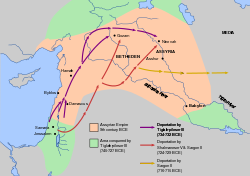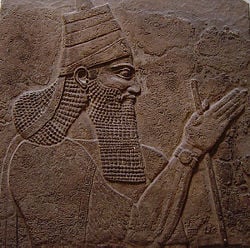Tiglath-Pileser III
Tiglath-Pileser III (from the Hebraic form[1] of Akkadian: Tukultī-apil-Ešarra, "my trust is in the son of Esharra") was a prominent king of Assyria in the 8th century B.C.E. (ruled 745–727 B.C.E.)[2][3] and is widely regarded as the founder of the Neo-Assyrian Empire.[4][5] He is considered to be one of the most successful military commanders in world history, conquering most of the world known to the ancient Assyrians before his death.
Etymology
The name Tiglath-Pileser was a throne-name — that is, one given to the king on his accession to the throne, rather than a name given at birth. In translation, it means "My Trust is the Heir of Ešarra." It is given in several different forms in historical records. The Bible records him as Tilgath-pilneser (2 Chronicles 28:20) and also as Pul (1 Chronicles 5:26 and 2 Kings 15:19,20). The latter resembles the name Pulu that some chronological sources give him as king of Babylonia. However, none of these sources are contemporary with Tiglath-Pileser's time, thus it remains uncertain if the name Pul was ever used during the king's life time.[6]
Origins
Former governor of Kalhu,[4] Pulu was a general who took his Assyrian throne name from two more legitimate predecessors. He calls himself a son of Adad-nirari III in his inscriptions, but it is uncertain if this is truthful. He seized the throne in the midst of civil war on 13 Iyyar, 745 B.C.E.[7] [The Assyrian Eponym List says "On the thirteenth day of the month of Airu Tiglath-Pileser took his seat on the throne"].[citation needed] As a result of Pulu seizing the throne in a bloody coup d'état, the royal family was slaughtered,[4] and Assyria was set on the path to empire in order to ensure the survival of the kingdom.[4]
Reign
Assyrian power in the Near East greatly increased as the result of Tiglath-Pileser's military reforms (see "Reforms" below) and his campaigns of conquest. Upon ascending the throne, he claimed (in Annal 9, which dates to 745 B.C.E., his first regnal year (accession year) to have annexed Babylonia, from "Dur-(Kuri)galzu, Sippar of Shamash, ... the cities [of Ba]bylonia up to the Uqnu river [by the shore of the Lo]wer [Sea]"[8] (which referred to the Persian Gulf), and subsequently placed his eunuch over them as governor. Also within the first of his regnal years, he defeated Urartu (in modern Armenia), whose hegemony under the rulership of Sarduri II had extended to northern Mesopotamia and Syria. He also defeated the Medes before proceeding against the Neo-Hittites, Syria and Phoenicia. He took Arpad in 740 B.C.E. after three years of siege, annexed it as a province (over which he placed one of his eunuchs as governors), and subjected Hamath to tribute. Assyrian inscriptions record, in the fifth year of his reign 740 B.C.E., a victory over Azariah (Uzziah), king of Judah, whose achievements are described in 2 Chronicles 26. In 733 B.C.E. his armies conquered Philistia on the Mediterranean coast, destroyed Damascus (732) and occupied most of Israel (732), with its northern regions becoming Assyrian provinces. According to the royal inscriptions of Tiglath-Pileser, many of the inhabitants were deported to other parts of the Assyrian empire, a practice that was commonly enacted by his predecessors.
In October 729 B.C.E. [citation needed], Tiglath-Pileser assumed total control of Babylon, capturing the Babylonian king Nabu-mukin-zeri (ABC 1 Col.1:21) and having himself crowned as "King Pulu of Babylon."
Biblical records

Biblical records, corroborated by Assyrian ones, describe how Tiglath-Pileser III exacted 1000 talents of silver tribute from King Menahem of Israel (2 Kings 15:19) and defeated his successor Pekah (15:29). Pekah had allied with Rezin, king of the Arameans against Ahaz (known to the Assyrians as Yahu-khazi), king of Judah, who responded by appealing for the Assyrian monarch's help with the Temple gold and silver. Tiglath-Pileser complied by seizing Damascus, executing Rezin, and deporting the Aramaean inhabitants to Kir (16:9). He also seized the northern half of Israel, and deported the Reubenites, Gadites, and Manasseh to Halah, Habor, Hara, and the Gozan river (1 Chron. 5:26). Despite the alliance, he apparently caused some trouble for Ahaz as well (2 Chron 28:20).
Reforms
Upon ascending the throne, Tiglath-Pileser instituted several reforms to different sectors of the Assyrian state, which arguably revived Assyria's hegemony over the Near East.
The first of such reforms entailed thwarting the powers of the high Assyrian officials, which during the reigns of his predecessors had become exceedingly high. Officials such as Šamši-ilu, who was turtanu and a prominent official since the time of Adad-Nirari III, often led their own campaigns and erected their own commemorative stelae, often without mentioning the king at all[10]. Since his earliest inscriptions (and thus from the beginning of his reign), he gave regular mention of appointing eunuchs as governors of (newly conquered) provinces; this removed the threat of provincial rule becoming a dynastic matter. He also sought to reduce the power of his officials by reducing the size of the provinces (in some cases the northern provinces were increased to include newly conquered territories), thus decreasing their resources, should they have desired to incite a revolt. Subsequently, there were more provinces, more governors (most of which were eunuchs), and less power per governor.
The second reform targeted the army. Instead of a largely native Assyrian army which normally campaigned only in the summer time, Tiglath-Pileser incorporated large numbers of conquered people into the army, thus adding a substantial foreign element. This force mainly comprised the infantry, whereas the native Assyrians comprised the cavalry and chariotry. As a result of Tiglath-Pileser's military reforms, the Assyrian Empire was armed with a greatly expanded army which could campaign throughout the year.
Campaigns
Legacy
Tiglath-Pileser III's conquests and reforms led to the establishment of the Neo-Assyrian Kingdom as a true empire. He built a royal palace in Nimrud (the so-called "central palace") later to be dismantled by Esarhaddon. On the sculptured slabs decorating his palace, across the bas-reliefs depicting his military achievements, he had engraved his royal annals.
On his death, he was succeeded by his son Ululayu, who took the name Shalmaneser V, who further campaigned in the Levant and captured Samaria.
See also
Template:ANE portal
- Kings of Assyria
Notes
- ↑ Tilgathpilneser—2 Chronicles 28:20 (Authorised King James Version)
- ↑ Assyrian Eponym List
- ↑ Tadmor, H. (1994). The Inscriptions of Tiglath-Pileser III, King of Assyria.pp.29
- ↑ 4.0 4.1 4.2 4.3 Healy, pp. 17
- ↑ history of Mesopotamia :: The Neo-Assyrian Empire (746-609) - Britannica Online Encyclopedia
- ↑ G. Frame, Babylonia 689-627, p. 303-305
- ↑ 11th edition of the Encyclopædia Britannica, 1911 [1]
- ↑ Tadmor, H. pp. 43
- ↑ Healy, pp. 21
- ↑ Shafer, A.T. (1998). The Carving of an Empire: Neo-Assyrian Monuments on the Periphery, p.32-33
ReferencesISBN links support NWE through referral fees
- Healy, Mark. The Ancient Assyrians, Tiglath-Pileser III, London: Osprey publ. ISBN 1855321637, OCLC 26351868
| Preceded by: Ashur-nirari V |
King of Assyria 745–727 B.C.E. |
Succeeded by: Shalmaneser V |
| Preceded by: Nabu-mukin-zeri |
King of Babylon 729–727 B.C.E. |
Template:Assyrian kings
Credits
New World Encyclopedia writers and editors rewrote and completed the Wikipedia article in accordance with New World Encyclopedia standards. This article abides by terms of the Creative Commons CC-by-sa 3.0 License (CC-by-sa), which may be used and disseminated with proper attribution. Credit is due under the terms of this license that can reference both the New World Encyclopedia contributors and the selfless volunteer contributors of the Wikimedia Foundation. To cite this article click here for a list of acceptable citing formats.The history of earlier contributions by wikipedians is accessible to researchers here:
The history of this article since it was imported to New World Encyclopedia:
Note: Some restrictions may apply to use of individual images which are separately licensed.

